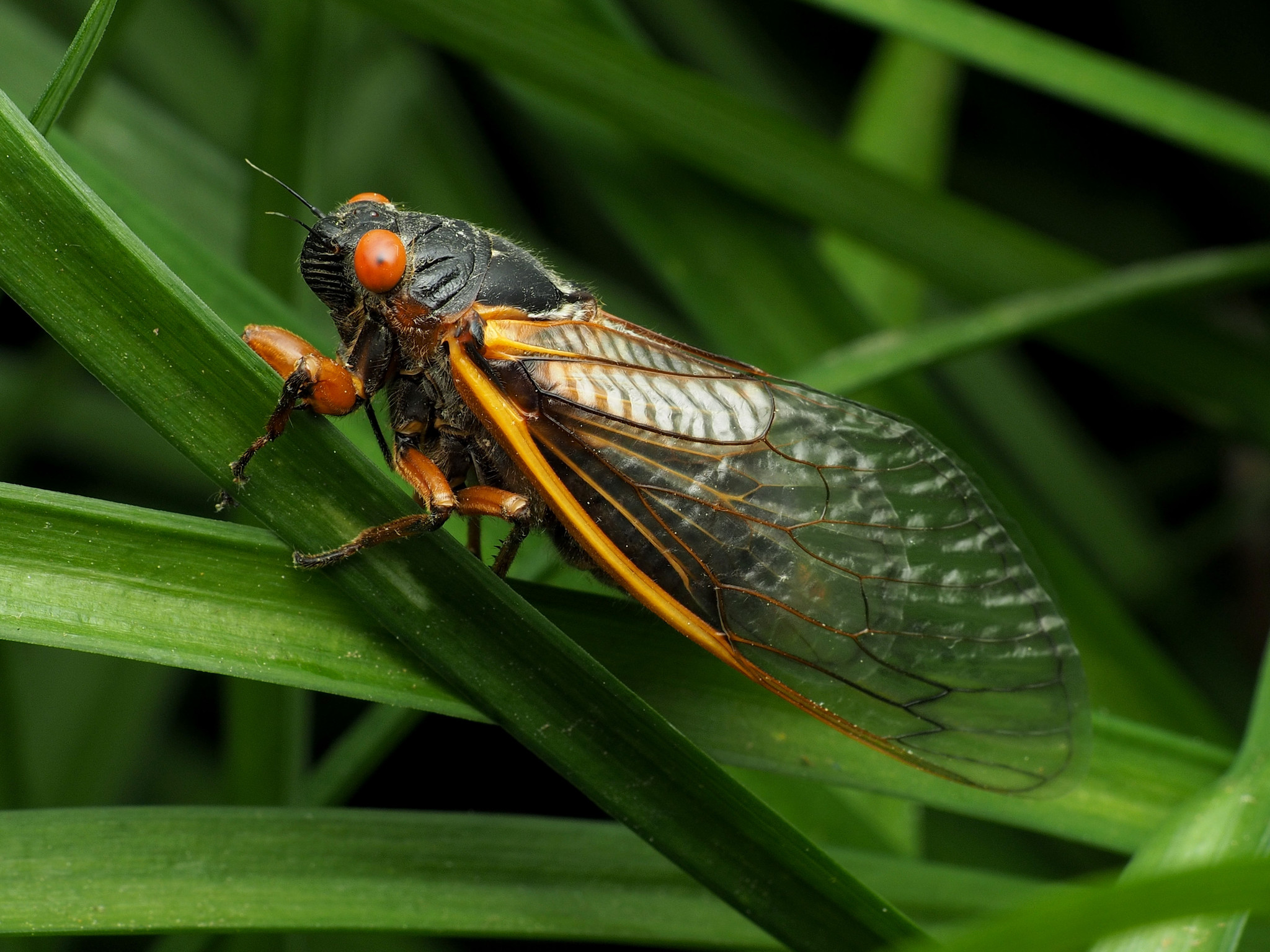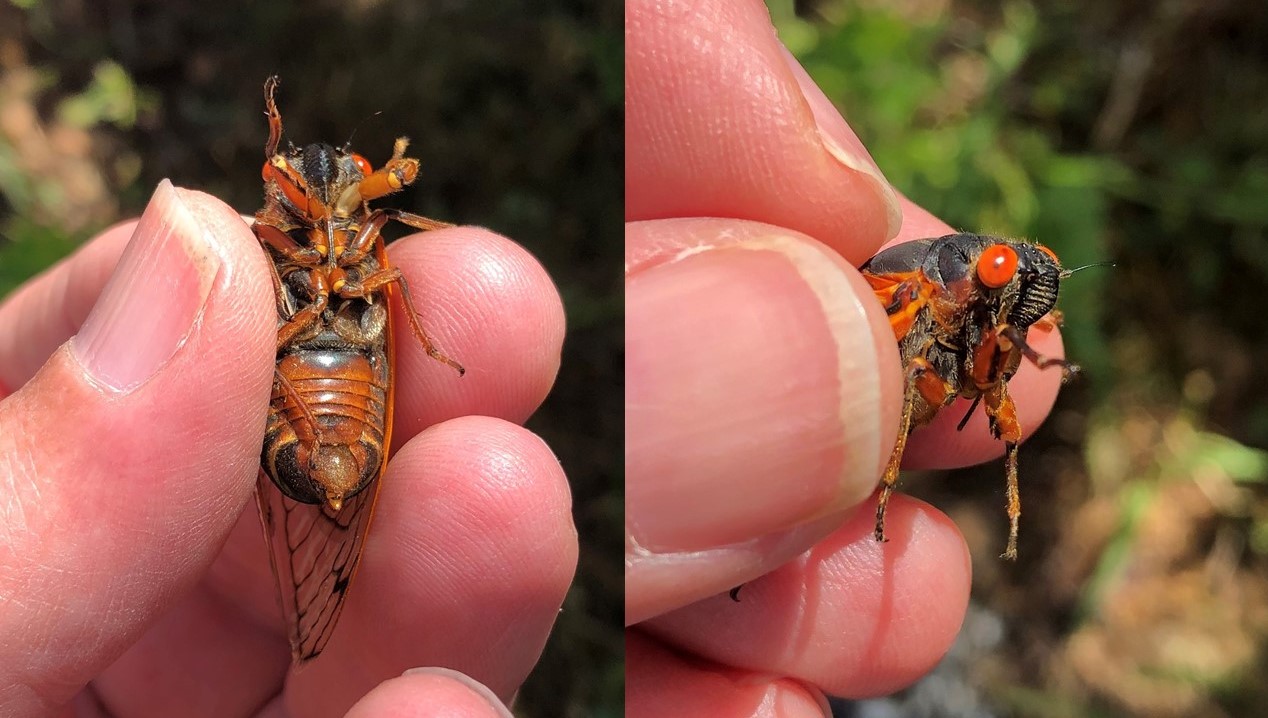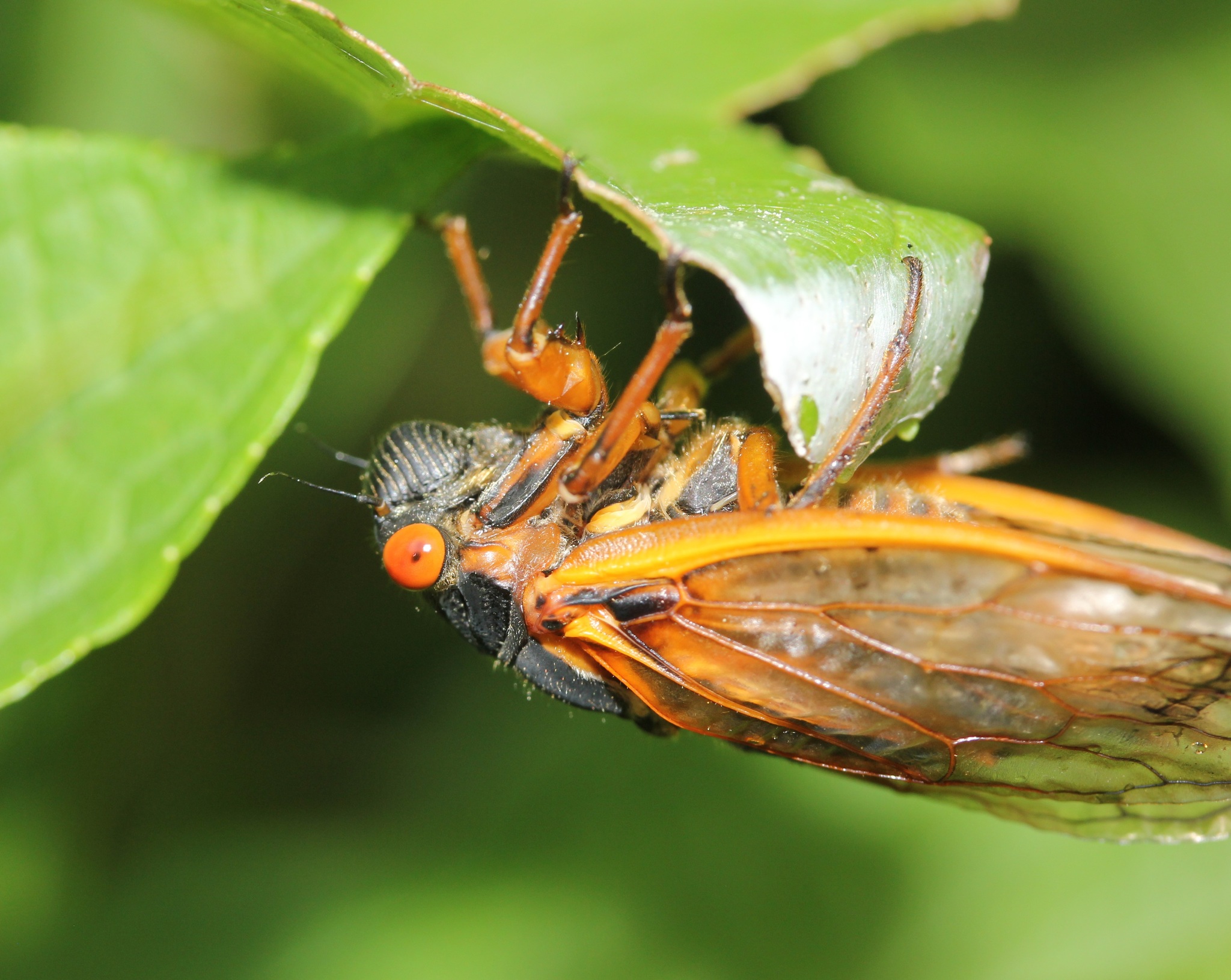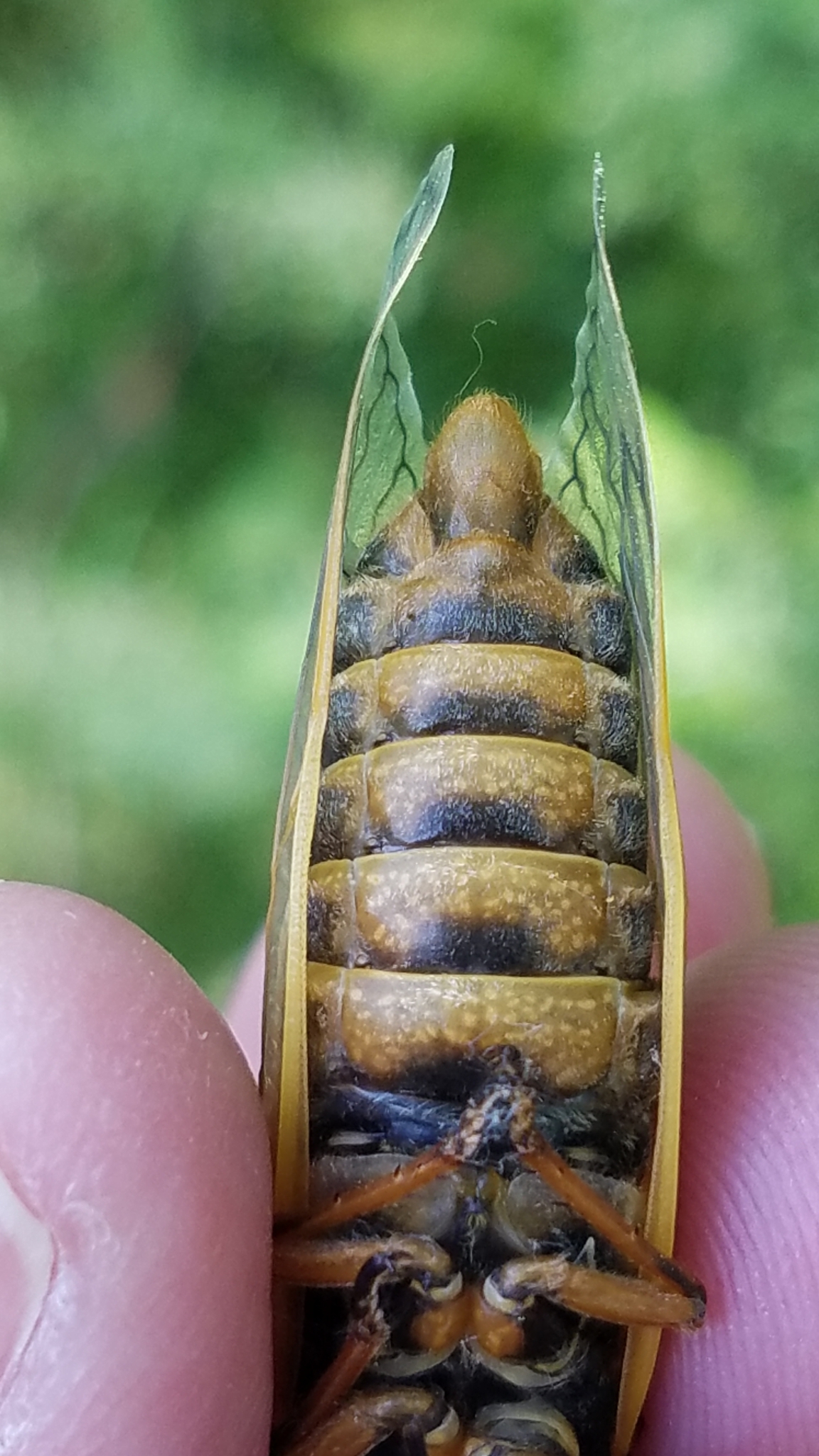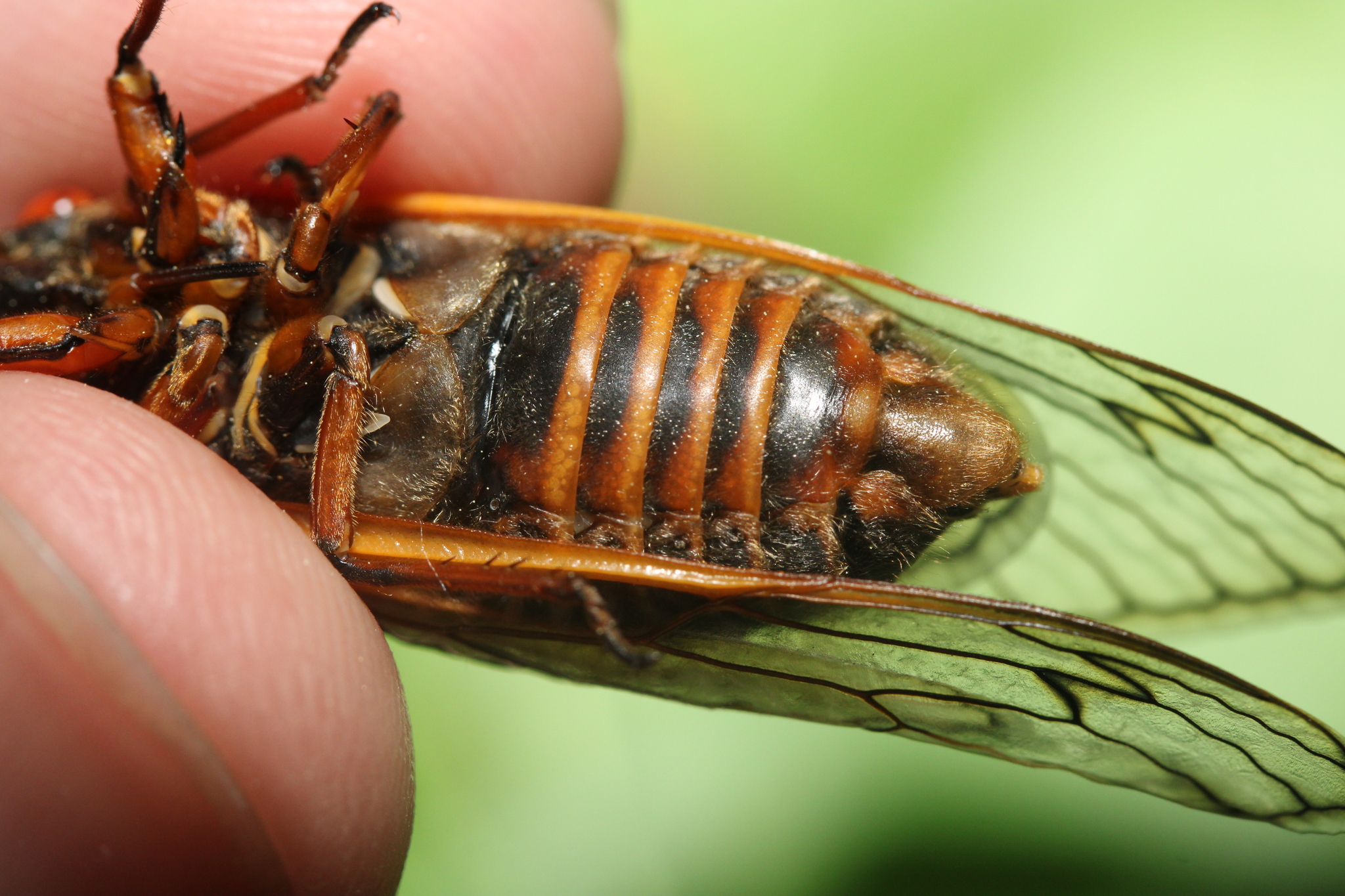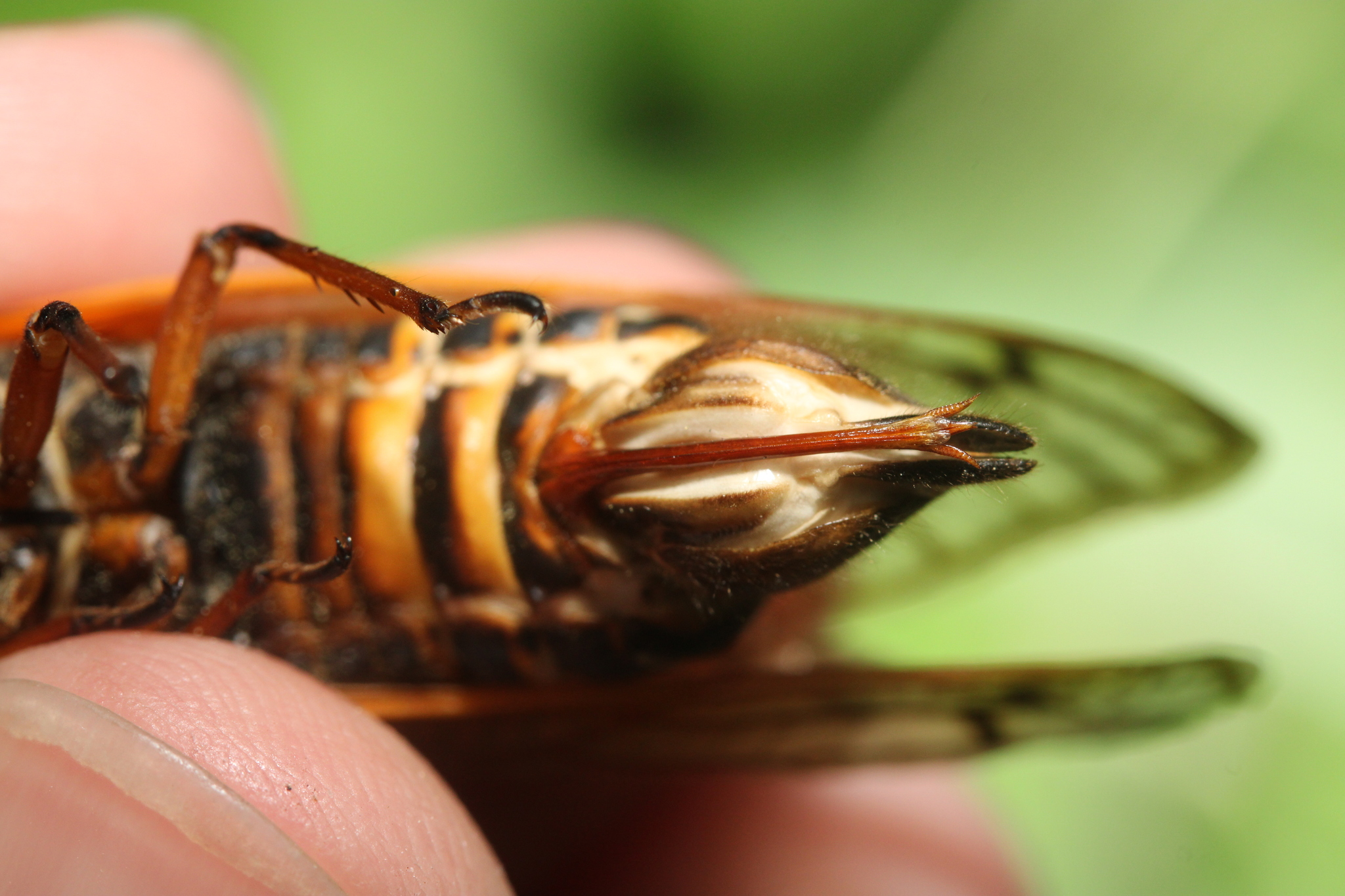Map Snapshot


















1,345 Records
Description
Compare other Magicica species. Try to get photos of the abdomen or record audio. Brood X will have broad orange stripes on abdomen (more orange than black). This species is larger than the other two species and the only one with the orange marking between the eye and the wing base. Because people tend to collect/document the largest cicadas they see, this species is probably over-sampled (R. Orr, pers. comm.). Song is also diagnostic. Report unidentified Periodical Cicada species and read general info at the genus page. Excellent info at Cicada Mania web site.
Relationships
Emerging nymphs documented as prey of Limax maximus (Norden & Williams, 2015).
Seasonality Snapshot
Source: Wikipedia
| Magicicada septendecim | |
|---|---|

| |
| Female | |

| |
| Male | |
| Scientific classification | |
| Domain: | Eukaryota |
| Kingdom: | Animalia |
| Phylum: | Arthropoda |
| Class: | Insecta |
| Order: | Hemiptera |
| Suborder: | Auchenorrhyncha |
| Family: | Cicadidae |
| Genus: | Magicicada |
| Species: | M. septendecim
|
| Binomial name | |
| Magicicada septendecim | |
Magicicada septendecim, sometimes called the Pharaoh cicada or the 17-year locust, is native to Canada and the United States and is the largest and most northern species of periodical cicada with a 17-year lifecycle.[3]
Description
[edit]Like other species included in Magicicada, the insect's eyes and wing veins are reddish and its dorsal thorax is black; it is distinguished by broad orange stripes on the underside of the abdomen and orange patches on the sides of the thorax between the eye and the forewings.[4] Its mating call is a high-pitched song said to resemble someone calling "weeeee-whoa" or "Pharaoh",[5] features it shares with the newly discovered 13-year species Magicicada neotredecim.[6]
Because of similarities between M. septendecim and the two closely related 13-year species M. neotredecim and M. tredecim, the three species are often described together as "decim periodical cicadas."
-
Mating pair
-
Two adults
-
Close-up in South Carolina
-
Female ovipositing
-
Three eggs
-
Specimen in the Bavarian State Collection of Zoology
Life cycle
[edit]Their median life cycle from egg to natural adult death is around seventeen years. However, their life cycle can range between thirteen and twenty-one years.[7]
Historical accounts of periodicity
[edit]Historical accounts cite reports of 15- to 17-year recurrences of enormous numbers of noisy emergent cicadas ("locusts") written as early as 1733.[8][9] John Bartram, a noted Philadelphia botanist and horticulturist, was among the early writers that described the insect's life cycle, appearance and characteristics.[10]
On May 9, 1715, the Rev. Andreas Sandel, the pastor of Philadelphia's "Gloria Dei" Swedish Lutheran Church, described in his journal an emergence of Magicicada's Brood X.[11] Pehr Kalm, a Finnish naturalist visiting Pennsylvania and New Jersey in 1749 on behalf of the Royal Swedish Academy of Sciences, observed in late May another emergence of that brood.[12][13] When reporting the event in a paper that a Swedish academic journal published in 1756, Kalm wrote:
The general opinion is that these insects appear in these fantastic numbers in every seventeenth year. Meanwhile, except for an occasional one which may appear in the summer, they remain underground.
There is considerable evidence that these insects appear every seventeenth year in Pennsylvania.[13]
Kalm then described Rev. Sandel's report and one that he had obtained from Benjamin Franklin that had recorded in Philadelphia the emergence from the ground of large numbers of cicadas during early May 1732. He noted that the people who had prepared these documents had made no such reports in other years.[13]
Kalm further noted that others had informed him that they had seen cicadas only occasionally before the insects emerged from the ground in Pennsylvania in large swarms on May 22, 1749.[13] He additionally stated that he had not heard any cicadas in Pennsylvania and New Jersey in 1750 in the same months and areas in which he had heard many in 1749.[13] The 1715 and 1732 reports, when coupled with his own 1749 and 1750 observations, supported the previous "general opinion" that he had cited.
Kalm summarized his findings in a book translated into English and published in London in 1771,[14] stating:
There are a kind of Locusts which about every seventeen years come hither in incredible numbers ... In the interval between the years when they are so numerous, they are only seen or heard single in the woods.[8][15]
Based on Kalm's account and a specimen that Kalm had provided, in 1758 Carl Linnaeus named the insect Cicada septendecim in the tenth edition of his Systema Naturae.[3][16]
In 1766, Moses Bartram described in his Observations on the cicada, or locust of America, which appears periodically once in 16 or 17 years the next appearance of the brood (Brood X) that Kalm had observed in 1749. Bartram noted that upon hatching from eggs deposited in the twigs of trees, the young insects ran down to the earth and "entered the first opening that they could find". He reported that he had been able to discover them 10 feet (3 m) below the surface, but that others had reportedly found them 30 feet (9 m) deep.[17]
In 1775, Thomas Jefferson recorded in his "Garden Book" Brood II's 17-year periodicity, writing that an acquaintance remembered "great locust years" in 1724 and 1741, that he and others recalled another such year in 1758 and that the insects had again emerged from the ground at Monticello in 1775. He noted that the females lay their eggs in the small twigs of trees while above ground.[18]
In April 1800, Benjamin Banneker, who lived near Ellicott's Mills, Maryland, wrote in his record book that he recalled a "great locust year" in 1749, a second in 1766 during which the insects appeared to be "full as numerous as the first", and a third in 1783 (Brood X). He predicted that the insects "may be expected again in the year 1800, which is seventeen years since their third appearance to me".[19]
References
[edit]- ^ World Conservation Monitoring Centre (1996). "Magicicada septendecim". IUCN Red List of Threatened Species. 1996: e.T12691A3373584. doi:10.2305/IUCN.UK.1996.RLTS.T12691A3373584.en. Retrieved 14 November 2021.
- ^ "NatureServe Explorer 2.0".
- ^ a b Alexander, Richard D.; Moore, Thomas E. (1962). "The Evolutionary Relationships of 17-Year and 13-Year Cicadas, and Three New Species (Homoptera, Cicadidae, Magicicada)" (PDF). University of Michigan Museum of Zoology. Retrieved 9 June 2011.
- ^ "Magicicada septendecim (L. 1758)". University of Connecticut. 16 February 2017.
- ^ Stranahan, Nancy. "Nature Notes from the Eastern Forest". Arc of Appalachia. Archived from the original on 5 October 2011. Retrieved 10 June 2011.
- ^ "Periodical Cicada Page". University of Michigan. Archived from the original on 5 September 2012. Retrieved 10 June 2011.
- ^ Campbell, Matthew (18 August 2015). "Genome expansion via lineage splitting and genome reduction in the cicada endosymbiont Hodgkinia - Supporting Information" (PDF). Proceedings of the National Academy of Sciences of the United States of America. 112 (33): 10192–10199. doi:10.1073/pnas.1421386112. PMC 4547289. PMID 26286984. Retrieved 13 October 2020.
- ^ a b Marlatt, C.L (1898). "The Periodical Cicada in Literature". The Periodical Cicada: An Account of Cicada Septendecim, Its Natural Enemies and the Means of Preventing its Injury, Together with a Summary of the Distribution of the Different Broods. United States Department of Agriculture: Division of Entomology: Bulletin No. 14 - New Series. Washington, D.C.: Government Printing Office. pp. 112–118. OCLC 1039550735. Retrieved July 29, 2021 – via Internet Archive.
- ^ Dudley, Paul (1733). Periodical Revolutions. Additional Manuscripts 4433, Folios 4-11, Division of Manuscripts of the British Library, London. Cited in Kritsky, Gene (2004). "John Bartram and the Periodical Cicadas: A Case Study (Reference No. 16)". In Hoffmann, Nancy E.; Van Horne, John C. (eds.). America's Curious Botanist: A Tercentennial Reappraisal of John Bartram 1699-1777. Philadelphia: The American Philosophical Society. p. 49. ISBN 978-0-87169-249-8. LCCN 2003050212. OCLC 891409264. Retrieved July 29, 2021 – via Google Books.
Moreover, the first time the Society had heard about periodical cicadas was from Paul Dudley, who sent a manuscript to the Society in 1733. .... Dudley correctly noted the seventeen-year life cycle and provided evidence. However, Collinson's paper shows that he used Bartram's claim of a fifteen-year cycle in his paper.
- ^ Kritsky, Gene (2004). "John Bartram and the Periodical Cicadas: A Case Study". In Hoffmann, Nancy E.; Van Horne, John C. (eds.). America's Curious Botanist: A Tercentennial Reappraisal of John Bartram 1699-1777. Philadelphia: The American Philosophical Society. p. 44. ISBN 978-0-87169-249-8. LCCN 2003050212. OCLC 891409264. Retrieved July 29, 2021 – via Google Books.
- ^ Sandel, Andreas (January 1906). "Extracts from the Journal of Rev. Andreas Sandel, Pastor of "Gloria Dei" Swedish Lutheran Church, Philadelphia, 1702-1719: May 9, 1715". The Pennsylvania Magazine of History and Biography. Vol. 30. Philadelphia: The Historical Society of Pennsylvania. pp. 448–449. ISSN 0031-4587. JSTOR 20085357. OCLC 1762062. Retrieved October 7, 2020 – via Google Books.
- ^ Kalm, Peter (1772). "Preface". Travels into North America; Containing Its Natural History, and a Circumstantial Account of Its Plantations and Agriculture in General, with the Civil, Ecclesiastical and Commercial State of the Country, the Manners of the Inhabitants, and Several Curious and Important Remarks on Various Subjects. Translated into English by John Reinhold Forster. Vol. 1 (2nd ed.). London: Printed for T. Lowndes, No. 77, in Fleet-street. pp. v–vii. ISBN 978-0-665-51501-9. LCCN 02013569. OCLC 1042021758. Retrieved August 24, 2021 – via Internet Archive.
- ^ a b c d e Davis, J.J. (May 1953). "Pehr Kalm's Description of the Periodical Cicada, Magicicada septendecim L., from Kongl. Svenska Vetenskap Academiens Handlinger, 17:101-116, 1756, translated by Larson, Esther Louise (Mrs. K.E. Doak)" (PDF). The Ohio Journal of Science. 53: 139–140. hdl:1811/4028. Archived (PDF) from the original on May 29, 2019. Republished by "Knowledge Bank". The Ohio State University Libraries and Office of the Chief Information Officer. Archived from the original on January 26, 2021. Retrieved October 2, 2012.
- ^ Kalm, Peter (1771). Travels into North America: Translated into English, By John Reinhold Foster. Vol. 2. London: T. Lowndess. pp. 212–213. Archived from the original on 5 May 2012. Retrieved 10 September 2020 – via Google Books..
- ^ Kalm, Peter (1771). Travels into North America: Translated into English, By John Reinhold Foster. Vol. 2. London: T. Lowndess. pp. 6–7. Retrieved September 10, 2020 – via Google Books.
- ^ Linnaei, Caroli (1758). Insecta. Hemiptera. Cicada. Mannifera. septendecim. Systema Naturae Per Regna Tria Naturae, Secundum Classes, Ordines, Genera, Species, Cum Characteribus, Differentiis, Synonymis, Locis. Vol. 1 (10 ed.). Stockholm, Sweden: Laurentii Salvii. pp. 436–437. Archived from the original on 25 March 2017. Retrieved 2017-05-24 – via Biodiversity Heritage Library (BHL).
- ^ Bartram, Moses (1766). Observations on the cicada, or locust of America, which appears periodically once in 16 or 17 years. Communicated by the ingenious Peter Collinson, Esq. The Annual Register, or a View of the History, Politicks, and Literature, for the Year 1767. London: Printed for J. Dodsley (1768). pp. 103–106. OCLC 642534652. Retrieved 2017-05-21 – via Google Books.
- ^ Jefferson, Thomas (1775). Betts, Edward Morris (ed.). "Thomas Jefferson's garden book, 1766-1824, with relevant extracts from his other writings". Memoirs of the American Philosophical Society. 22. Philadelphia: American Philosophical Society (1944): 68. LCCN 45001776. OCLC 602659598. Retrieved 2017-05-20 – via Google Books.
Dr. Walker sais he remembers that the years 1724 and 1741 were great locust years. we all remember that 1758 was and now they are come again this year of 1775. it appears that they come periodically from the ground once in 17 years. they come out of the ground from a prodigious depth. it is thought they eat nothing while in this state, laying their eggs in the small twigs of trees seems to be their only business. The females make a noise well known. The males are silent.
- ^ (1) John H. B. Latrobe (1845). Memoir of Benjamin Banneker: Read before the Maryland Historical Society at the Monthly Meeting, May 1, 1845. Baltimore, Maryland: Printed by John D. Toy. pp. 11–12. OCLC 568468091. Retrieved 2015-10-07 – via Google Books.
(2) Barber, Janet E.; Nkwanta, Asamoah (2014). "Benjamin Banneker's Original Handwritten Document: Observations and Study of the Cicada". Journal of Humanistic Mathematics. 4 (1): 112–122. doi:10.5642/jhummath.201401.07. ISSN 2159-8118. OCLC 700943261. Archived from the original on August 27, 2014. Retrieved 2014-08-26. Page 115, Fig. 3: Image of page in Benjamin Banneker's Astronomical Journal, 1791-1806. Manuscript written by Benjamin Banneker (MS 2700). Special Collection. Maryland Historical Society, Baltimore, Maryland: "The first great Locust year that I can Remember was 1749. .... ")
External links
[edit] Media related to Magicicada septemdecim at Wikimedia Commons
Media related to Magicicada septemdecim at Wikimedia Commons Data related to Magicicada septemdecim at Wikispecies
Data related to Magicicada septemdecim at Wikispecies





